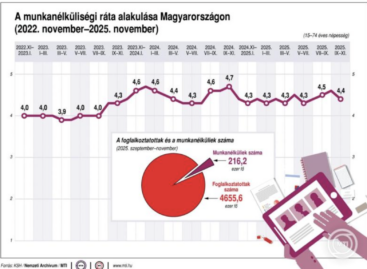Who will work? The following years of the Hungarian labor market
In the next 20 years (including 2024), roughly 2,600,000 people will pass the current retirement age of 65, while no more than 1,900,000 people will enter the labor market (on average at the age of 20)[1]. Thus, in twenty years, there will be at least 700,000 fewer people of economically active age in Hungary, if the current retirement age is still in effect. Thus, employment will decrease by 530,000 people.
The lost workforce can be offset in a number of ways: bringing home the largely highly qualified workforce living abroad, cutting back on sectors that require a large amount of manual labor (labor can thus flow to other, more efficient areas), and further involving the workforce reserve. However, the further inclusion of the current 300,000 potential workforce is highly questionable: from this number, among others, those unable to work due to health or physical obstacles, and those already employed but working illegally[2] must be subtracted. Thus, only a narrow and hard-to-reach layer can be involved, which cannot increase the number of people active in the labor market very much in the short term.
In principle, declining employment also reduces the wage bill. In the following, we will take the earnings of 2023 as a basis. According to the 2023 data, average earnings will increase until the age of thirty-five, after which they will stagnate or decrease slightly. This is not realistic in the future, which is why we no longer expect a decrease in earnings over the age of 35 (in an ascending system). According to the KSH, real wage growth in the last 20 years was 3.1% per year[3], so we estimate this for the next twenty years as well.
Related news
Yettel is once again among the best domestic employers
🎧 Hallgasd a cikket: Lejátszás Szünet Folytatás Leállítás Nyelv: Auto…
Read more >Teleworking has proven successful for more than a quarter of Hungarian companies, and they do not intend to change their practices in the next year or two
🎧 Hallgasd a cikket: Lejátszás Szünet Folytatás Leállítás Nyelv: Auto…
Read more >The number of employees in trade and public administration increased annually
🎧 Hallgasd a cikket: Lejátszás Szünet Folytatás Leállítás Nyelv: Auto…
Read more >Related news
(HU) A nap mondása
🎧 Hallgasd a cikket: Lejátszás Szünet Folytatás Leállítás Nyelv: Auto…
Read more >(HU) A nap mondása
🎧 Hallgasd a cikket: Lejátszás Szünet Folytatás Leállítás Nyelv: Auto…
Read more >(HU) A nap mondása
🎧 Hallgasd a cikket: Lejátszás Szünet Folytatás Leállítás Nyelv: Auto…
Read more >








